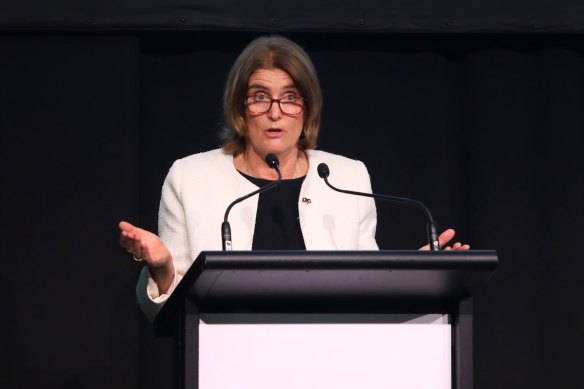This was published 1 year ago
Opinion
New governor, same mission: RBA sticks with unpopular rate rises
Elizabeth Knight
Business columnistThere was an inevitability about this year’s Melbourne Cup interest rate rise - and it began two weeks ago when inflation came in hotter than expected. Ultimately for the new Reserve Bank boss Michele Bullock, this couldn’t go unanswered.
Bullock had been in her honeymoon period with Australia’s mortgage borrowers since she took the RBA’s governor role in mid-September.
It’s now over.

Michele Bullock’s hand was forced by persistently high inflation. Credit: Bloomberg
Prepared for her role as inflation gladiator, she has sacrificed popularity and is ready to shrug off headlines like “horror rates call” to achieve the Reserve Bank’s goal to get inflation back to between 2 and 3 per cent.
As the RBA noted in its statement on Tuesday, inflation is proving more persistent than the central bank had expected just a few months ago and “the prices of many services are continuing to rise briskly”.
While some were lulled into a false sense of security when after three months of rate stability Bullock kept them on hold again in October, that was a decision made before the recent inflation reading demonstrated the inflation genie was fighting to stay outside the bottle.
Two weeks ago, during her maiden speech as RBA governor, Bullock took a lot of mystery out of her stance on getting inflation under control over the next two years.
The RBA would “not hesitate to raise the cash rate further if there is a material upward revision to the outlook for inflation”, she declared, demonstrating her hawkish chops.
So when September inflation figures came in the following day, traders and economists knew how to place their bets.
The data, combined with Bullock’s transparency and clarity, was enough for most major economists to huddle around the view that rates would move up at the November meeting.
This further ploughed the road for Bullock to increase rates – the anticipation removed the shock.
In a fortuitous piece of timing for Bullock, last week the International Monetary Fund called on the Reserve Bank to lift interest rates further to step up the inflation fight in Australia.
The IMF also had some advice for our state and federal governments: cut or delay some $150 billion worth of promised roads, railways and tunnel projects that are stoking inflation.
But perhaps one of the more meaningful data points for Bullock has been the start of the bank profit season. While only one bank – Westpac – has so far announced its results for the year to September, its numbers on loan arrears and delinquencies showed that most borrowers were managing to meet their monthly interest payments, and many were ahead or had money in offset accounts.
Westpac’s chief executive Peter King even noted that borrowers were managing to keep up with credit card payments, which are traditionally a riskier product for lenders.
While the collective credit quality numbers remain sound, Tuesday’s 25 basis point hike will tip some additional borrowers into stress and may take some of the heat out of the property market rebound, according to property analytics group CoreLogic.
And not all economists are in sync with the RBA’s call on inflation.
“Recent inflation has been driven by specific factors like higher global oil prices and rents rather than broad spending pressures. In fact, underlying growth in retail turnover remains at historically low levels while wage growth remains subdued,” said Deloitte Access Economics partner Stephen Smith.
He contends that “with increases to the cash rate only effective at reducing demand-led inflation, it is hard to see what a November rate hike achieves other than making it harder for Australians to pay their mortgage in the lead-up to Christmas.”
The Market Recap newsletter is a wrap of the day’s trading. Get it each weekday afternoon.